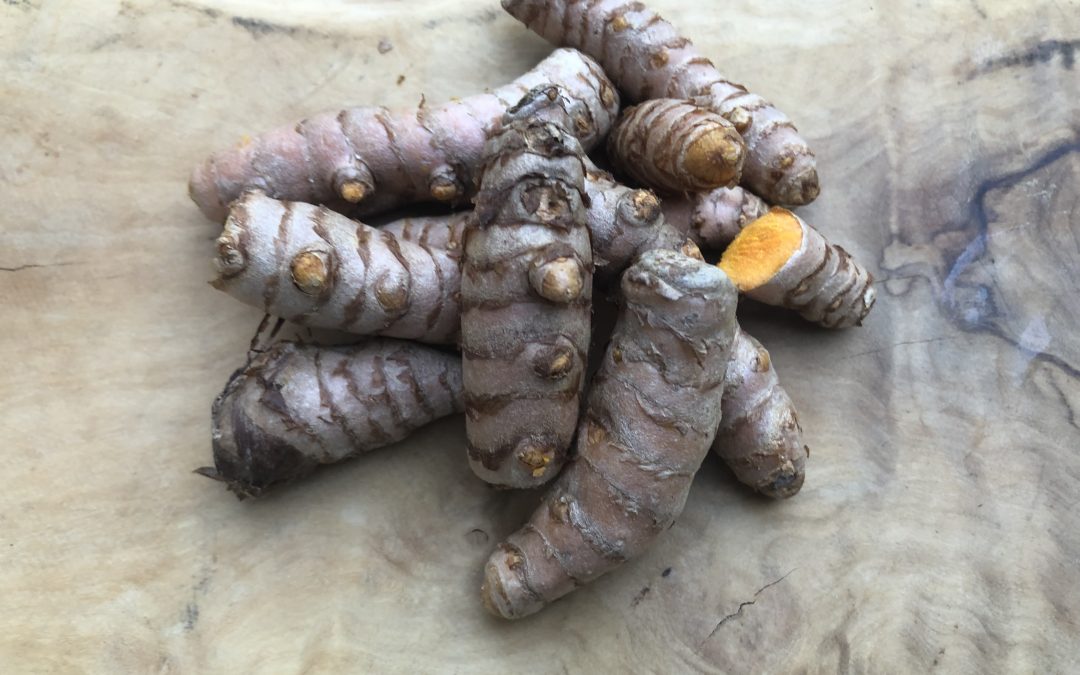Scientific research provides us with the vast array of the health benefits of turmeric. Here, we explore this from an Ayurvedic perspective to bring you what has been known for thousands of years through the practice of this traditional medicine.
It is well documented that turmeric has powerful anti-inflammatory and antioxidant properties. It is also known to promote digestion, support the brain and nervous system and maintain joint mobility.
This is an excerpt from a paper written by Dr Deepika Rodrigo B.A.M.S (Bachelor of Ayurvedic Medicine and Surgery) of the Ayurveda Institute UK and Ayurvedic Clinic – the largest and most pioneering providers of Ayurvedic training outside Asia.
We can take this knowledge and apply it to how we use this wonderfully therapeutic spice to maintain balance and harmony for all the dosha.
‘The modern findings have created an avalanche of advice, often conflicting, about how to use turmeric to cure disorders and for general well-being. Modern nutritional advice on the use of turmeric ranges from taking two tablespoons, twice a day to drinking turmeric tea 4 times a day, or even drinking the fresh juice of turmeric! As a result, many of us just feel confused.
So, the real question therefore, is HOW to use it …
To know how to use it, we must first embrace the whole understanding. Ayurveda has vast experiential knowledge of herbs and medicinal plants that goes back for thousands of years. It is here we can find the answers.
Modern and traditional medicine agree that turmeric is very powerful. However, just as with any powerful machine if we don’t know how to use it properly, we can easily cause an accident. In the same way, when we start using any herb which is very powerful without proper understanding, it is likely to create accidents or unwanted side effects which may show themselves immediately or emerge with time.
We need to have some understanding of two principles in Ayurveda – samyoga (combination) and sanskara (preparation). So, in order to use turmeric, we need to know both what to combine it with and how to prepare it. Don’t worry, we don’t need be an Ayurvedic doctor to know this! Traditionally, the way it has been used for centuries has good reason behind it. The guidance on how to use it can all be found there.
Combination and preparation
Ruksha (drying) and ushna (heating) are two predominant qualities of turmeric in addition to its medicinal properties. Therefore, when we consume turmeric it can create a heating or drying effect in the body and can aggravate certain kinds of disorders such as vata and pitta conditions. It is worth noting here that so many of the predominant disorders in the West are the cause of imbalance of pitta and vata, such as hormonal imbalances, urinary tract disorders, IBS, arthritis, fertility issues, and skin disorders to name but a few.
This is also why you will never hear of anyone in Asia consuming two tablespoons of turmeric twice a day. When turmeric is used in Asia it is always used in combination with something unctuous (oily) to counteract the drying effect and something cooling to balance the heating effect. The most common ways of using turmeric in Asia involve combinations with other spices, vegetables, lentils, milk or ghee (clarified butter) and so on. In this way there is some molecular interaction with other elements which reduces the heating and drying effect of turmeric whilst allowing us to benefit from its medicinal effect. This is because turmeric used alone goes straight into the stomach and liver creating the drying and heating effect. Used in cooking with other spices and ingredients, we are practising safe efficacy.
Ayurveda has always known that the extraction of the single active ingredient (which is the basis of so many preparations in Western medicine) is not what nature intended. This is because the root itself (and sometimes the leaves used in certain preparations) contains chemicals that have a synergistic and antagonistic effect (meaning here that it suppresses unwanted effects in the body).
So we want to capture the special properties of turmeric (prabhava). This is contained within its volatile organic component (VOC) and has the most powerful vibrational action to help detoxify and restore the intelligence of the liver. The special property of turmeric is that when dried in natural sunlight it particularly good at retaining the goodness in the sunlight more than most other foods. Once ingested in the body it releases the energy of the sunlight. This is also why raw turmeric is rarely ingested in Asia, as it hasn’t had the benefit of natural sun drying’.
We can apply this knowledge to winter recipes for each dosha.
Turmeric’s bitter, pungent and astringent tastes, and Rukshna (drying) and Ushna (heating) qualities are particularly balancing Kapha dosha which possesses the predominant qualities of cold and moist. The qualities of winter reflects these qualities, so for Kapha individuals turmeric is a great addition when cooking.
This recipe not only captures the heating and drying qualities of turmeric, but also emphasises these qualities by using foods and other spices with the same qualities. Individuals with a strong Kapha influence, may experience an accumulation of mucous in their chest during autumn and winter as the temperature drops and the moisture in the atmosphere increases.
To truly understand Kapha dosha, we just need to look at the qualities of mucous – sticky, moist, cold and stagnant. To rid the body of an accumulation of Kapha we need there transformational energy of fire (Pitta), to warm it up and get it moving.
Smokey Beans with Spinach. Kapha Balancing
Ingredients:
- 150g Cannellini Bean (soaked overnight)
- 2 fresh tomatoes, roughly chopped
- 1 red pepper, roughly chopped
- 4 black garlic cloves (or regular garlic)
- 1 medium red onion.
- 1tsp Paprika
- 1tsp Turmeric
- 2tsp cumin seeds
- 2tsp coriander seeds
- 1 tsp caraway seeds
- Salt and pepper to taste.
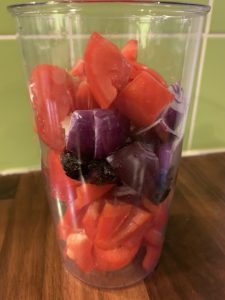 Dry roast and grind all whole spices. Blend tomatoes, pepper, onion and garlic to make a smooth sauce.
Dry roast and grind all whole spices. Blend tomatoes, pepper, onion and garlic to make a smooth sauce.
The black garlic adds a pungent note, but if you don’t have black garlic, regular garlic is also very balancing for Kapha. Add all ingredients, with a little extra water, to a slow cooker and cook on a very low heat overnight.
You can also do this on the hob on a very low heat, just watch it doesn’t dry out.
Here the beans are served with a little sautéed spinach and cumin. Other options would be: with a little rice and green veg or Smokey bean taco’s.
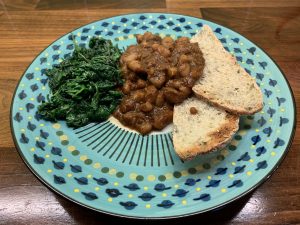
Smokey Beans
If consumed in excess turmeric can aggravate Vata and Pitta dosha. By adding oil and combining it will other cooling spices or foods we can limit the drying and heating effect and gain the full medicinal benefits of this therapeutic spice without aggravating the doshas.
Butternut Squash Soup: Vata Balancing
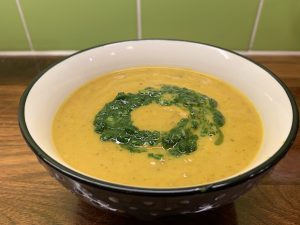
Butternut Squash Soup
Ingredients:
- 1 small butternut squash.
- 2 carrots
- 1 red onion
- 2 tsp cumin seeds
- 2tsp coriander seeds
- 1 tsp caraway seeds
- 1 tsp turmeric
- 2 cloves garlic
- 1 thumb size piece of ginger
- 750mls water
- 1tbs olive oil.
Dry roast whole spices and grind. Roughly chop all vegetables. Finely chop garlic and ginger. Fry off spices in the oil and add all other ingredients. Cook gently for 30mins the add water. Simmer until vegetables are cooked and blend to a smooth consistency. Here we have served it with a drizzle of herb oil. Simply blend parsley and basil in olive oil and a little salt. This will keep in the fridge for a few days.
Corn and Potato Chowder: Pitta Balancing
Ingredients:
- 150g Fresh or frozen corn.
- 3-4 potatoes cubed
- 1 medium onion
- 2 cloves garlic.
- 1tsp cumin seeds
- 1tsp coriander seeds
- 1/2tsp turmeric
- Salt and Pepper
- 750mls water
- 1tbs olive oil
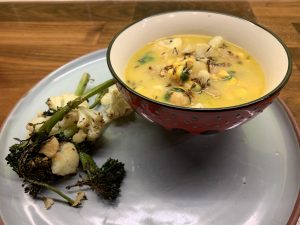
Corn and Potato Chowder
Dry fry and grind whole spices. Fry in a little oil, finely chopped onion, garlic and the rest of the spices. Add potatoes and gently cook for 10 mins. Add corn and water and cook until vegetables are soft. Here the chowder is served with roasted broccoli and cauliflower wit cumin.
A turmeric based night-time drink to aid restful sleep, aid digestion and detoxification.
Suitable for all the doshas. For Kapha dosha, choose almond milk. 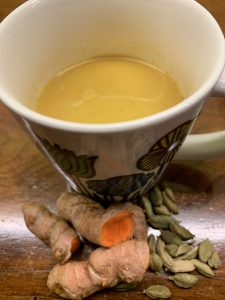
Add a pinch of turmeric, cinnamon, ginger, black pepper and 2 cardamon pods to a glass of cow’s milk or almond milk. Simmer for 5 mins to allow the spices infuse and drink 30mins before bed.
Enjoy trying out these recipes. Enhancing your diet with the powerful, health giving properties of turmeric and bringing balance to the doshas. You can find out more about Ayurveda by attending one of our workshops. The next one is our Ayurvedic Seasonal Cleanse on Saturday 11th January at 1pm. Find out more about the workshop here or you can book a consultation with Clare, Ayurvedic Practitioner at Lotus Studio, Highams Park. Clare undergone her training under the expert guidance of Dr Deepika Rodrigo (BAMS) at the Ayurveda Institute UK.

